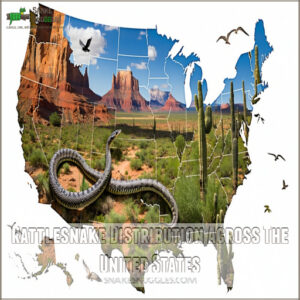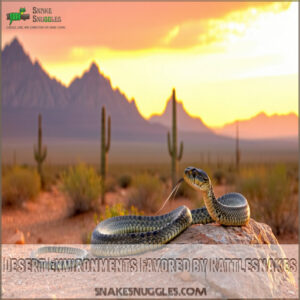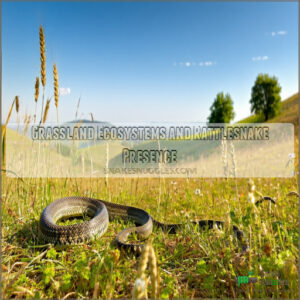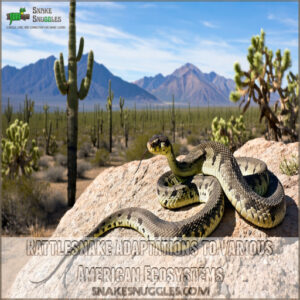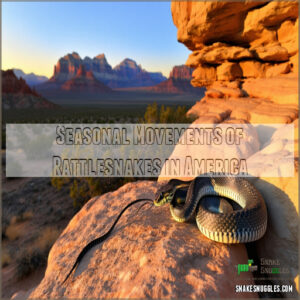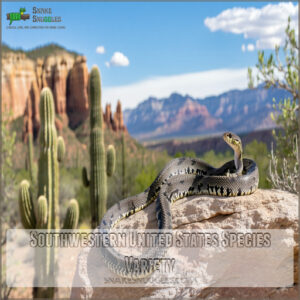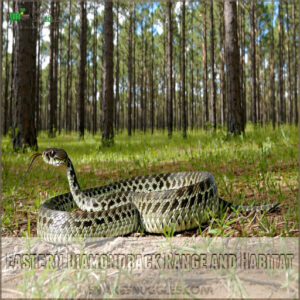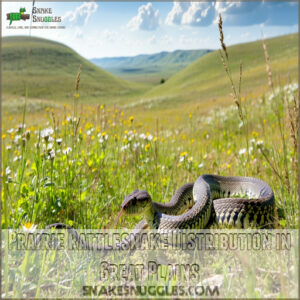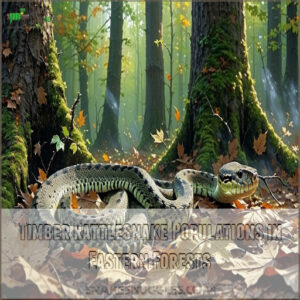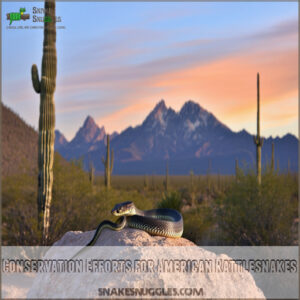This site is supported by our readers. We may earn a commission, at no cost to you, if you purchase through links.

You’ll find these venomous vipers in a variety of habitats, from the sunny deserts of the Southwest to the forests and grasslands of the East Coast.
They’re absent in colder states like Alaska and Hawaii, but present in most others.
Arizona is a hot spot, with 14 species, and Texas, New Mexico, and California also have their fair share, as these snakes are versatile, but they love a good desert.
So, if you’re out hiking in rattlesnake country, keep your eyes peeled and your boots on—and read on to learn more about where these snakes call home and how to stay safe.
Table Of Contents
- Key Takeaways
- Rattlesnake Distribution Across The United States
- States With Highest Rattlesnake Populations
- Rattlesnake-Free States in America
- Preferred Habitats of American Rattlesnakes
- Rattlesnake Adaptations to Various American Ecosystems
- Urban Encroachment on Rattlesnake Territories
- Seasonal Movements of Rattlesnakes in America
- Rattlesnake Species Diversity by Region
- Environmental Threats to Rattlesnake Habitats
- Conservation Efforts for American Rattlesnakes
- Frequently Asked Questions (FAQs)
- How Can I Protect Rattlesnakes From Persecution?
- What Do Rattlesnakes Typically Eat?
- How Long Can Rattlesnakes Live?
- What is the Most Toxic Rattlesnake Venom?
- What Are the Signs of a Rattlesnake Bite?
- Where in the US do rattlesnakes live?
- Which US state has the most rattlesnakes?
- Which states have no rattlesnakes?
- What parts of the US can you find rattlesnakes?
- Where are rattlesnakes found in the US?
- Conclusion
Key Takeaways
- Rattlesnakes are widespread across the continental United States, but you won’t find them in Alaska, Hawaii, Maine, or Rhode Island due to their cold climates or geographic isolation.
- Arizona is the state with the highest number of rattlesnake species, boasting 14 different types of these venomous snakes. Texas, New Mexico, and California also have a significant number of species.
- These snakes are versatile and can be found in a variety of habitats, including deserts, forests, grasslands, and even swamps. They are skilled at adapting to their environment and have a strong preference for sunny, arid regions.
- While rattlesnakes are dangerous and their bites require immediate medical attention, human-snake conflicts can be minimized through effective urban planning, rattlesnake removal services, and public education initiatives.
Rattlesnake Distribution Across The United States
Rattlesnakes are widespread across the lower 48 states, slithering through a variety of habitats and climates.
They’re absent in colder regions like Alaska and Hawaii, but in most other states, you might come across these snakes.
So, it’s important to know where they live and how to stay safe, especially around rattlesnakes and their habitats.
Range of Rattlesnake Species in America
So, you’re curious about rattlesnake territory, huh?
These slithery creatures have quite the range across the US, and they’ve got some favorite spots.
Rattlesnake Range:
- They’re found across the continental US and beyond.
- From the blistering Southwest to Canada, they’ve got a wide reach.
- You’ll spot ’em in arid regions, especially in the American Southwest and Mexico.
- East of the Mississippi River? Yep, they’re there too.
- Even South America is home to a few species.
Understanding rattlesnake habitats is vital for grasping their distribution and behavior.
Now, let’s explore why these places…
Factors Influencing Rattlesnake Distribution
Regarding rattlesnake habitats, it’s not just about deserts.
Their slithery presence across the USA depends on a bunch of factors, like habitat variety—they love those plains and hills—prey availability, and elevation.
Climate change, human activities, and diseases are also big players in this ecosystem dance, shaping where these snakes thrive and struggle.
It’s a delicate balance that influences their geographic range and rattlesnake territory, shown on a US map of rattlesnake territory.
Geographic Variations in Rattlesnake Populations
Rattlesnake populations shift across the US map.
Picture them moving from coastal shores to desert habitats and mountain ecosystems.
Rivers create natural barriers, shaping regional snake patterns and rattlesnake distribution.
Habitat suitability, like thriving desert ecosystems, influences where you’ll find them.
Prey availability is key, ensuring these stealthy hunters have a steady food supply in their chosen states with highest rattlesnake population.
Impact of Climate on Rattlesnake Habitats
Climate change is pushing American rattlesnakes out of their comfort zones, impacting their habitats and your chances of spotting one.
With rising temps, these snakes are expanding their horizons, seeking new homes, and adapting to climate shifts.
Droughts and unpredictable weather create habitat loss, forcing them to slither into new territories.
This thermal tolerance leads to geographic isolation, altering rattlesnake distribution and increasing surprise encounters.
As a result, understanding climate change effects is vital in predicting their behavior and habitat expansion, and recognizing the impact of climate change on their distribution, to ultimately grasp the rattlesnake‘s new patterns.
States With Highest Rattlesnake Populations
If you’re wandering through states like Arizona, Texas, or California, keep an eye out—these hotspots are rattlesnake central.
With their warm climates and perfect habitats, it’s no surprise these slithery neighbors have made themselves right at home in hotspots like these.
Arizona’s Diverse Rattlesnake Species
Arizona is a rattlesnake mecca, with a whopping 15 species—a true wonderland for snake enthusiasts.
These desert snakes come in various colors, patterns, and sizes, adapting to diverse habitats.
Here’s what makes Arizona so special:
- Venom Potency: From the deadly Western Diamondback to the less venomous species, Arizona rattlesnakes pack a range of punches.
- Unique Subspecies: The Arizona Ridge-Nosed Rattler is a local celebrity, with its distinct look and "sky island" habitat.
- Habitat Preferences: From deserts to woodlands, Arizona offers a smorgasbord of homes for rattlesnakes.
- Human-Snake Conflict: With snakes and humans crossing paths, conservation and safety are key.
- Conservation Challenges: Protecting these species and their habitats is a delicate balance.
With these factors in mind, it becomes clear that Arizona’s rattlesnake population is a complex and multifaceted ecosystem that requires careful consideration and management.
Texas and Its Rattlesnake-rich Regions
Texas is a rattler’s paradise, hosting ten species of these slithery creatures.
From the Western Diamondbacks of West Texas to the Timber Rattlesnakes of the piney woods in East Texas, each region has its unique variety.
Understanding their habitats is key to both public safety and conservation.
Check out this table for a quick overview of Texas rattlesnake regions:
| Region | Species |
|---|---|
| West Texas | Western Diamondback |
| Hill Country | Rock Rattlesnake |
| East Texas | Timber Rattlesnake |
Remember, these snakes are just going about their day—they don’t want trouble.
Knowing their habitats helps us give them space and protect them.
New Mexico’s Rattlesnake Hotspots
New Mexico gives Texas a run for its money in terms of rattlesnake hotspots.
With 42 species, including the Western Diamondback and rock rattlesnake, it’s a haven for these vipers.
From the Chihuahuan Desert to the Rocky Mountains, New Mexico offers a diverse range of ecosystems for rattlesnakes to call home.
- Picture these snakes slithering through the desert sands, seeking shelter among rocky outcrops.
- They’re skilled hunters, using their heat-sensing pits to detect prey.
- You might spot them coiled in the sun, warming their cold-blooded bodies.
- Remember to keep your distance and appreciate their role in the natural balance.
California’s Rattlesnake Diversity
California is a haven for rattlesnake diversity, hosting seven species, including the famed Western Diamondback.
These serpents have adapted to the state’s varied landscapes, from deserts to forests, showcasing the ecological tapestry of the Western United States.
Their survival skills are impressive, but human impacts like habitat loss pose significant threats.
Understanding rattlesnake migration and behavior is key to preserving these iconic western rattlesnakes.
Rattlesnake-Free States in America
While rattlesnakes slither and strike their way through most of the continental US, there are a few lucky states where you won’t have to watch your step quite as carefully.
Alaska, Hawaii, Maine, and Rhode Island are the only rattlesnake-free zones in the country, thanks to their less-than-hospitable climates or geographic isolation, making them distinct due to their geographic isolation.
Alaska’s Cold Climate and Lack of Rattlesnakes
You won’t find rattlesnakes slithering across Alaska’s icy terrain.
Its frigid winters and chilly summers are a deal-breaker for cold-blooded reptiles.
Alaska’s frozen tundras and evolving arctic ecosystems never needed venomous snakes.
So, you can chase those northern lights without worrying about snakes, and consider Alaska as a snake-free zone, which makes it perfect for a unique adventure.
Enjoy the unique, snake-less adventure!
Hawaii’s Island Isolation From Rattlesnakes
Hawaii’s island ecosystem is a snake-free zone, thanks to its unique volcanic origins and oceanic isolation.
The Aloha State’s tropical climate is unsuitable for rattlesnakes, creating a natural barrier.
Strict biosecurity measures further guarantee these slithering reptiles don’t slip through.
So, you can explore Hawaii’s lush landscapes without worrying about unexpected encounters with rattlesnakes.
Maine’s Unsuitable Habitat for Rattlesnakes
Maine’s cold climate and rocky terrain aren’t exactly a welcoming committee for rattlesnakes.
These cold-blooded creatures need warmth and places to hide, but Maine’s like that uninviting neighbor—all frost and rocks.
- Frosty winters: Brrr! It’s a no-go for sun-loving rattlers.
- Rocky landscape: Limited dens and hidey-holes.
- Low biodiversity: Not much food around.
- Harsh winters: Even less food, and tougher to find.
It’s a peace offering from nature to hikers and campers.
Rhode Island’s Absence of Native Rattlesnakes
Why Rhode Island? Its cool, humid climate isn’t ideal for rattlers.
Add a lack of rocky habitats and limited prey, and you’ve got yourself a snake-free zone.
Rhode Island’s unique geography and climate set it apart from other states.
It’s no surprise that rattlesnakes give this place a hard pass.
| State | Climate | Habitat |
|---|---|---|
| Rhode Island | Cool & Humid | Limited Rocky Habitats |
| Alaska | Extremely Cold | Sparse Suitable Habitat |
| Hawaii | Isolated & Tropical | None |
Now, let’s slither over to another snakeless state with a unique geography, and explore its climate and habitat.
Preferred Habitats of American Rattlesnakes
Rattlesnakes have a knack for making their homes in a variety of habitats across America, from the sunny deserts of the Southwest to the dense forests of the East.
They’re versatile creatures, but they do have their preferences, and understanding their favored spots is key to knowing where you might stumble upon one, especially in their favored spots.
Desert Environments Favored by Rattlesnakes
Desert snakes know a thing or two about survival.
They’re like sun-seekers, mastering the art of chilling in the hottest spots.
But it’s not just about soaking up rays; it’s a delicate dance of energy conservation and clever hunting.
- Denning Sites: Rattlesnakes carefully choose where to set up camp, selecting spots that offer the perfect temperature control.
- Prey Feast: The desert’s their buffet, with an endless supply of small animals to satisfy their hunger.
- Camouflage Pros: Their patterns blend seamlessly into the sand, keeping them hidden from both prey and predators.
- Heat Regulation: These snakes are pros at managing the desert’s extreme temps, knowing just when to slither into the shade.
- Unique Habits: From water-conserving coils to nocturnal hunting, rattlesnakes have adapted to thrive in arid landscapes.
Forested Areas Supporting Rattlesnake Populations
Forested areas are prime real estate for rattlesnakes, offering shelter and an all-you-can-eat rodent buffet.
These snakes are pros at camouflage, slithering through leaf litter and hiding among trees.
| Species | Habitat |
|---|---|
| Timber Rattlesnake | Eastern forests |
| Eastern Diamondback | Forested areas of the Southeast |
| Western Diamondback | Occasionally found in California’s oak woodlands |
As urban sprawl threatens these snake-hidden havens, protecting their habitats becomes essential for survival.
Grassland Ecosystems and Rattlesnake Presence
Grasslands are nature’s sprawling stage, where rattlesnakes play a starring role in maintaining ecosystem balance.
They’re the ultimate pest control, keeping rodent populations in check across vast habitats.
Rattlesnake dens in grasslands are an indicator of their adaptability, ensuring their survival despite habitat loss.
Supporting wildlife conservation in these areas is a win-win, preserving biodiversity and the delicate balance of nature.
Swamp and Wetland Rattlesnake Habitats
Have you ever wondered about the slithery secrets of rattlesnakes in swampy settings?
These reptiles are right at home in wetland areas across America.
Their waterproof skin is a handy adaptation, ensuring they can swim and slither through soggy terrain with ease.
But it’s not just about survival—wetlands provide an abundance of prey, making it a tasty treat for these water-loving snakes.
Unfortunately, the destruction of these habitats puts rattlesnakes in a tricky situation, so let’s chat about preserving their lively slither in these unique ecosystems.
Rattlesnake Adaptations to Various American Ecosystems
Rattlesnakes are masters of adaptation, and their ability to thrive in diverse ecosystems across America is a demonstration of that.
From the scorching deserts to the chilly mountains, these snakes have evolved unique traits, like heat-sensing organs and camouflage techniques, to survive and prosper in their environments.
Heat-sensing Organs for Desert Survival
As the sun sets over the desert, rattlesnakes come alive.
Their secret weapon? Heat-sensing organs that give them an edge in the dark.
These snakes aren’t just slithering around blindly; they’re using thermal imaging to find their next meal.
With pit organs that detect infrared, rattlesnakes can sense tiny temperature differences, making them masters of desert survival.
This skill guides them through the vast American rattlesnake habitats, ensuring they never miss a beat (or a tasty treat).
Camouflage Techniques in Different Environments
Rattlesnakes are stealthy ninjas, masters of disguise.
Their skin patterns offer the perfect desert camouflage, disappearing in sandy dunes.
In forests, they vanish with earthy tones, experts at forest blending.
Grassland hiding and rock mimicry enhance their sneaky survival skills.
These adaptation tactics help rattlesnakes thrive in diverse habitats, keeping them safe and well-hidden from predators and unsuspecting humans with their sneaky survival skills.
Behavioral Adaptations to Cold Climates
How do rattlesnakes survive the winter chill?
Through a process called brumation, rattlesnakes master cold climate survival.
They gather in communal dens, sharing body heat to stay cozy, which is a clever trick for cold-blooded creatures.
This adaptation lets them tolerate frosty temps, and their impressive frost tolerance and thermal regulation skills guarantee they emerge safely come spring.
It’s nature’s version of a slumber party, keeping Jack Frost at bay until warmer days return.
Swimming Abilities in Aquatic Habitats
Did you know rattlesnakes are agile swimmers? These snakes sleekly navigate aquatic habitats, showcasing three impressive adaptations:
- Muscular bodies: Their strong build enables swift water crossings, handy for escaping predators.
- Heat-sensing superpowers: In murky waters, rattlesnakes use heat-sensing pits to track prey with precision.
- Venomous defense: While their venom keeps threats at bay, it’s a reminder to stay vigilant, even near water, in rattlesnake habitats.
Understanding their swimming behavior patterns is essential for coexisting with these animals.
So, the next time you’re by a lake or river, remember these snakes are skilled at water navigation and keep an eye out!
Urban Encroachment on Rattlesnake Territories
As cities sprawl into rattlesnake habitats, you’re more likely to cross paths with these fascinating reptiles. Learn how urban development impacts rattlesnakes and what you can do to safely coexist.
Human-rattlesnake Conflicts in Expanding Cities
Stepping out for some fresh air, you spot a rattler on your porch. Yikes! With urban sprawl squeezing their habitats, these slithery neighbors might get a little too close for comfort.
Human-snake conflict calls for smarter urban planning, effective rattlesnake removal, and a dash of snake relocation.
- Sunbathing on the sidewalk, a rattler soaks up the rays, oblivious to the startled pedestrians.
- You hear a faint rattle under your deck—yup, it’s a rattlesnake nest.
- Gardening takes a turn for the wild when a rattler greets you from the rose bushes.
Effective rattlesnake removal services are vital in minimizing human-snake conflicts in urban areas.
Conservation Efforts in Urban Areas
As cities expand, rattlesnake habitats shrink, and conservation efforts become a tricky business.
Rattlesnake relocation programs move snakes to safer spots, and public education initiatives teach folks how to coexist peacefully.
Community outreach is key to getting everyone on board, but funding can be a snake pit of challenges.
Sharing knowledge about these scaly neighbors is essential for their protection and our safety.
Effective urban planning often involves using Urban Wildlife strategies to minimize human-snake conflicts, which is crucial for coexist peacefully and conservation efforts.
Rattlesnake Relocation Programs
Rattlesnake relocation programs offer a thoughtful approach to snake handling, focusing on gentle relocations to more natural habitats.
These initiatives aim to balance ethical considerations, such as minimizing stress on snakes, with the practical challenges of public perception and funding.
By tracking success rates, these programs confirm their positive impact on both human and rattlesnake coexistence.
With a blend of science and compassion, rattlesnake relocation becomes a key part of species monitoring and wildlife transport, ensuring safe rattlesnake distribution back to suitable habitats.
Effective safe snake removal techniques are vital for the success of these relocation programs, as they prioritize the well-being of both humans and snakes.
Public Education on Coexisting With Rattlesnakes
While relocating snakes helps, education lights the path to true coexistence.
You’ll find that rattlesnake awareness programs make sharing space with these creatures simpler than you’d think.
Through venom education and bite prevention strategies, you’ll learn that these animals aren’t the villains movies make them out to be.
Smart coexistence strategies start with understanding their habitats and behavior patterns – it’s all about respect, not fear.
Seasonal Movements of Rattlesnakes in America
You’ll find rattlesnakes playing a year-round game of musical chairs across America, from their cozy winter dens to their summer hunting spots.
When winter’s chill sets in, they’ll head to their hibernation hideouts, only to emerge in spring for food and sunshine, making their seasonal moves as predictable as your neighbor’s holiday decorations, involving a constant search for hibernation hideouts.
Winter Denning Behaviors and Locations
Finding warmth during winter, our scaly friends seek out strategic denning sites in limestone caves and rock crevices.
During the cold months, you’ll discover these winter dens packed with drowsy rattlesnakes in brumation, their metabolism slowed by 70%.
Here’s what makes the perfect winter habitat:
- South-facing locations for maximum sun exposure
- Deep underground burrows for temperature control
- Natural rock formations providing essential shelter
- Shared spaces with other snake species for warmth, which helps in temperature control.
Spring Emergence Patterns Across Regions
Like clockwork, nature’s alarm rings differently across America’s rattlesnake habitats.
Check your regional Snake Migration calendar carefully:
| Region | Spring Habitat | Emergence Timing |
|---|---|---|
| Southwest | Desert Dens | February-March |
| Southeast | Forest Floor | March-April |
| Midwest | Rocky Areas | April 15-May 7 |
| Northeast | Mountain Slopes | Late May |
Regional Temperature patterns trigger this annual dance, with snakes emerging once temperatures consistently hit 60°F.
Summer Hunting Grounds and Activity
When warm weather patterns kick in, american rattlesnakes switch to nature’s night shift for their summer foraging adventures.
These crafty hunters use built-in heat sensors to track down prey, making every strike count.
- Snake activity peaks at dawn and dusk, when temperatures feel just right
- Western rattlesnakes prefer shaded rocks as their hunting grounds
- They’re masters at catching rodents and rabbits during their nocturnal prowls
- Their hunting strategies adapt perfectly to the summer heat waves
Fall Migration to Hibernation Sites
Time to pack those summer bags!
When temperatures drop below 50°F, these serpents kick off their fall migration to winter dens.
In places like West Virginia, they’ll trek up to 3,642 feet to reach their hibernation sites .
You’ll often spot them following familiar routes back to their cozy hibernation spots, where they’ll gather in groups for winter survival.
Their denning behavior varies by region—a Minnesota snake bundles up way earlier than its Texas cousins.
Rattlesnake Species Diversity by Region
You’ll find an amazing variety of rattlesnakes across America, from the fierce Eastern Diamondbacks in Florida to the hardy Prairie Rattlers in Montana’s grasslands.
If you’re in Arizona, you’re in the rattlesnake capital of America, where you can spot 14 different species slithering through diverse landscapes from desert floors to mountain peaks.
Southwestern United States Species Variety
The Southwest’s crown jewel of species diversity shines brightest in the desert landscapes.
You’ll find an impressive 14 different species in Arizona alone, while California hosts 12 unique types of these remarkable creatures.
The fascinating Southwestern Speckled Rattlesnake shows off nature’s artistry, sporting colors that match its rocky home – from pink to blue to striking black-and-white patterns.
From the tiny Twin-Spotted rattler in mountain forests to the adaptable Banded Rock dweller at 8,000 feet, these southwestern habitats showcase nature’s incredible variety.
Eastern Diamondback Range and Habitat
Moving east from the desert dwellers, you’ll find the mighty Eastern Diamondback prowling through Southeast Ecosystems from North Carolina to Florida.
These impressive serpents call pine forests and coastal scrublands home, where they’re masters of camouflage .
- Snake habitats include gopher tortoise burrows for winter Rattlesnake Denning
- Habitat Fragmentation threatens their survival in sandy coastal plains
- Their range spans up to 500 meters in elevation
- Snake Conservation efforts focus on protecting pine flatwoods
Prairie Rattlesnake Distribution in Great Plains
Across the vast expanse of prairie habitats, the prairie rattlesnake reigns as North America’s most widely distributed rattlesnake species .
These remarkable creatures use heat-sensing pits to track prey throughout the Great Plains, from Canada to Mexico.
Despite local declines, they’ve proven resilient in their natural range.
- Snake denning occurs in grassland burrows and rocky outcrops
- Plains conservation efforts focus on protecting breeding grounds
- Western rattlesnakes typically live 16-20 years in the wild
- Rattlesnake migration patterns follow seasonal prey movements
Timber Rattlesnake Populations in Eastern Forests
Deep in the eastern forests, where timber rattlesnakes master the art of camouflage, you’ll spot these remarkable Eastern species blending with fallen leaves.
They’ve got prime timber habitat from Wisconsin to New Hampshire, though their populations are sadly shrinking.
While they’re not typically aggressive, Forest Conservation efforts are essential as these skillful hunters face habitat loss and human conflicts, making their future uncertain.
Environmental Threats to Rattlesnake Habitats
You’ll find that rattlesnakes today face a perfect storm of threats, from climate change forcing them to abandon their usual haunts to farming operations bulldozing their homes.
If you’re wondering why you’re seeing fewer rattlers in your area, it’s because everything from intense wildfires to pollution is putting these remarkable reptiles in a tight spot.
Climate Change Impacts on Rattlesnake Distribution
Rising temperatures are reshaping America’s rattlesnake distribution, turning these cold-blooded creatures into climate migrants.
You’ll notice these changes affecting their thermal tolerance and ecosystem resilience.
Here’s what scientists are seeing:
- Snake populations shifting to cooler, higher-elevation areas
- Changes in breeding patterns and den locations
- Reduced hibernation periods impacting their natural cycles
The climate shift hits some species harder than others, especially in states with highest rattlesnake populations.
Their survival depends on how well they adapt to these habitat disruptions.
Habitat Loss Due to Agricultural Expansion
Modern agricultural expansion is reshaping America’s landscape faster than you might think.
By 2050, land conversion for farming could impact up to 90% of animal habitats, including essential rattlesnake territories.
As farmers clear natural spaces for crops, habitat fragmentation splits snake populations and disrupts entire ecosystems.
You’ll notice these changes through biodiversity loss in areas where agricultural impacts hit hardest.
The good news is that smart farming techniques like crop rotation and sustainable practices can help protect these remarkable reptiles while ensuring food security for everyone.
Effects of Wildfires on Rattlesnake Populations
Fire ecology shows a tough reality for America’s scaled survivors.
When wildfires tear through their territories, rattlesnake populations face intense challenges.
Here’s what happens when flames meet fangs:
- Smoke impacts force snakes to flee their hiding spots
- Burned habitats eliminate essential shelter and hunting grounds
- Ash effects change the soil chemistry where they hunt
Urban snake populations often rely on urban snake habitats to survive.
Yet these resourceful reptiles prove remarkably adaptable, slowly reclaiming their scorched homes as plant life returns.
Pollution and Its Impact on Rattlesnake Ecosystems
Beyond the smoke and flames, a silent threat lurks in rattlesnake habitats.
Chemical runoff and toxic waste seep into their hunting grounds, poisoning the small mammals they rely on.
Water pollution disrupts entire food chains, while pesticides alter the ecosystem’s delicate balance.
You’ll find these effects rippling through the environment, from direct toxicity impacts to subtle changes in species interactions, making chemical runoff a significant concern.
Conservation Efforts for American Rattlesnakes
You’ll be glad to know that protected areas and breeding programs are helping our scaly friends bounce back from the brink in many states, with Arizona leading the charge to save its 14 native species.
If you’re interested in joining the effort, you can support research projects and conservation groups that work to protect these essential predators who keep our ecosystems in balance.
Protected Areas for Threatened Rattlesnake Species
Ten essential wildlife reserves across America’s eastern states shelter our threatened timber rattlesnake populations.
You’ll find these protected zones tucked within rugged mountainous terrain and dense forests, providing safe havens for these remarkable creatures.
Species sanctuaries in Pennsylvania have put the brakes on development and hunting, while habitat restoration projects are breathing new life into these areas.
Conservation strategies, from legal protection to wildlife conservation initiatives, are helping these protected areas serve as strongholds for native rattlesnake species.
Breeding Programs for Endangered Populations
Scientists at leading conservation centers have launched groundbreaking breeding programs for endangered species preservation .
Through genetic research and population monitoring, you’ll find dedicated teams working to protect America’s most vulnerable rattlesnake species .
The Los Angeles Zoo just welcomed six baby New Mexico ridge-nosed rattlesnakes into their conservation program.
Understanding the challenges of rattlesnake interbreeding is essential for these efforts.
- A baby rattler taking its first breath gives hope for an entire species
- Each successful breeding brings us closer to restoring natural balance
- Local communities rally to support these misunderstood creatures
- Years of careful matchmaking pay off in tiny miracles
- Your support helps keep these ancient bloodlines alive
Research Initiatives on Rattlesnake Ecology
You’re helping conservation by learning about rattlesnake ecology.
| Rattlesnake | Habitat | Conservation |
|---|---|---|
| Eastern Diamondback | Southeast | Protected areas |
| Western Diamondback | Southwest | Research initiatives |
| Timber Rattlesnake | Eastern forests | Breeding programs |
Understanding their distribution aids conservation, as seen in.
Effective management of rattlesnake habitats is essential for the survival of these species.
Legislation Protecting Rattlesnake Habitats
While you might think laws protecting rattlesnakes are rare, they’re actually vital for keeping these iconic creatures safe.
Here’s how rattlesnake conservation laws, including the Endangered Species Act, help:
- Habitat preservation laws protect their homes.
- Funding guarantees anti-venom availability, keeping both rattlers and humans safe.
- Anti-poaching measures maintain ecosystem balance, guaranteeing these snakes remain a beneficial presence.
Rattlesnakes were here first, and these laws help preserve their place!
Frequently Asked Questions (FAQs)
How Can I Protect Rattlesnakes From Persecution?
You can help by advocating for conservation efforts, respecting their habitats, and educating others. Support protected areas and research initiatives to guarantee these misunderstood creatures thrive.
What Do Rattlesnakes Typically Eat?
Rattlesnakes relish rodents, making meals of mice and other small critters.
They’re cold-blooded hunters, using heat-sensing pits to detect their warm-blooded prey.
These snakes play a pivotal role in maintaining nature’s balance.
How Long Can Rattlesnakes Live?
Well, that depends. In the wild, rattlesnakes typically live around 10 years, but some can survive up to 20 or 30 years. In captivity, they might live even longer.
What is the Most Toxic Rattlesnake Venom?
Variety is the spice of life," and that’s true even for rattlesnake venom.
The Western Diamondback takes the cake for most toxic venom, but all rattlesnake bites are dangerous and require immediate medical attention.
What Are the Signs of a Rattlesnake Bite?
You’ll see one to two puncture wounds, swelling, bruising, and intense pain. Nausea, dizziness, and difficulty breathing can also occur. Get help fast!
Where in the US do rattlesnakes live?
Did you know Arizona has 14 rattlesnake species? You’ll find these venomous vipers in most US states, excluding Alaska and Hawaii, but they love the warmer spots.
Which US state has the most rattlesnakes?
Arizona is the state with the most rattlesnake species, with 14 calling it home. It’s a hotspot for these slithery creatures, so watch your step when exploring the Grand Canyon State!
Which states have no rattlesnakes?
You won’t bump into rattlesnakes in Alaska, Hawaii, Maine, or Rhode Island. These states are too chilly for their comfort, so they’ve steered clear.
What parts of the US can you find rattlesnakes?
You’ll find these slithery critters in most US states, lurking in diverse habitats.
They’re big fans of the sun and warm temps, so they skip the chilly states like Alaska and Maine.
Where are rattlesnakes found in the US?
You’ll find rattlesnakes slithering across most of the lower 48 states, from deserts to forests. They’re absent in colder spots like Alaska, Hawaii, Maine, and Rhode Island.
Conclusion
So, you’re curious about where rattlesnakes hang out in the US?
Well, these slippery customers are found slithering across most of the country, from sunny Arizona to the forests of the East Coast.
They’re versatile, that’s for sure, but they love a good desert.
Keep your eyes peeled in the states mentioned, and you’ll likely spot these venomous vipers.
Stay aware, stay safe, and always keep your boots on when hiking in rattlesnake country!

